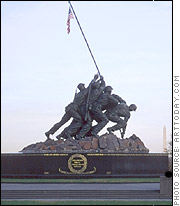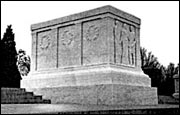Veterans Day

Veterans' statistics, history of the holiday, war poetry, and more
 Iwo Jima Memorial, Washington, D.C.  Tomb of the Unknowns, Arlington National Cemetery, Arlington, Va. |
Armistice Day Becomes Veterans Day
World War I officially ended on June 28, 1919, with the signing of the Treaty of Versailles. The actual fighting between the Allies and Germany, however, had ended seven months earlier with the armistice, which went into effect on the eleventh hour of the eleventh day of the eleventh month in 1918. Armistice Day, as November 11 became known, officially became a holiday in the United States in 1926, and a national holiday 12 years later. On June 1, 1954, the name was changed to Veterans Day to honor all U.S. veterans.
In 1968, new legislation changed the national commemoration of Veterans Day to the fourth Monday in October. It soon became apparent, however, that November 11 was a date of historic significance to many Americans. Therefore, in 1978 Congress returned the observance to its traditional date.
Tomb of the Unknowns
Official, national ceremonies for Veterans Day center around the Tomb of the Unknowns.
To honor these men, symbolic of all Americans who gave their lives in all wars, an Army honor guard, the 3d U.S. Infantry (The Old Guard), keeps day and night vigil.
At 11 a.m. on November 11, a combined color guard representing all military services executes "Present Arms" at the tomb. The nation's tribute to its war dead is symbolized by the laying of a presidential wreath and the playing of "Taps."
Unknown Soldier Identified
On Memorial Day (which honors U.S. service people who died in action) in 1958, two more unidentified American war dead, one from World War II and the other from the Korean War, were buried next the unknown soldier of World War I.
A law was passed in 1973 providing interment of an unknown American from the Vietnam War, but because of the improved technology to identify the dead, it was not until 1984 that an unidentified soldier was buried in the tomb.
In 1998, however, the Vietnam soldier was identified through DNA tests as Michael Blassie, a 24-year-old Air Force pilot who was shot down in May of 1972 near the Cambodian border. His body was disinterred and reburied by his family in St. Louis, Missouri.
Special Features | The History of War |
The War Dead | Veterans |
America's Wars—Military Conflicts in U.S. History | |
The American RevolutionWar of 1812Mexican WarCivil WarSpanish American WarWorld War IWorld War IIKorean War | Vietnam WarThe Persian Gulf WarAfghanistan War
Iraq War |
The U.S. Military | Worldwide Conflicts and Wars |
